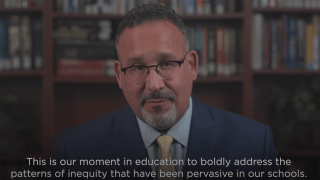Since March of 2020, thought leaders and policymakers have discussed how to use the COVID-19 pandemic as an opportunity to reform schools.
The first event of the Equity Summit Series, hosted by the U.S. Department of Education, attempted to more clearly define actions being taken to address long-standing inequities as most K-12 schools start to fully reopen.
“Normalcy is not a place I want to go back to,” said school leadership expert Baruti Kafele in a panel discussion.
Kafele joined a panel of educational professionals from across the country, including USC Rossier Dean Pedro Noguera, superintendents, an award-winning teacher and school counselor, and others.
The event also featured remarks from First Lady Jill Biden and U.S. Education Secretary Miguel Cardona.
“How do we harness the momentum of this moment?” asked moderator Cindy Marten, U.S. Deputy Secretary of Education, a question likely echoed by many school districts that are committed to equity and bolstered by American Rescue Plan funds.
Here are some of the Equity Summit panel’s top insights:
Increase communication with parents
The majority of panelists agreed that schools should engage families to better serve students, especially as the country faces a student mental health crisis exacerbated by the pandemic.
Whether it’s an informal coffee chat between parents and school leaders, a survey or a dedicated focus group, parents can provide insight into students’ needs that educators may not otherwise know.
Embrace creative solutions
Schools should “think holistically about the needs of children,” commented Noguera. Focusing on academics and standard school operations may not be enough to fully support students if they are experiencing other personal challenges.
Here are some examples of how panelists’ districts responded to student needs:
- Mental health clinics for families on site
- Free transportation to school for students in need
- After determining that a low-income school was located in a “laundromat desert,” school leaders added laundry services on site to increase attendance.
“As we recover from this pandemic, it’s on all of us to ensure we don’t return to the same broken systems of the past, but build back better than before.” —First Lady Jill Biden
“Equity is not a passing buzzword, but an ongoing, continuous effort to make sure that every student feels supported in their classrooms and in every educational environment.” —U.S. Education Secretary Miguel Cardona
Use data as an equity tool
“We have myriad variables that we’re tracking,” noted an administrator from the Miami-Dade County Public School District. Data can be used among internal teams to assess a variety of issues, including those related to equity.
There is no one-size-fits-all solution to solving problems, said Superintendent Alberto Carvalho, also from Miami-Dade. With data (and a staff trained to interpret it), schools can determine more targeted support for students depending on their level of need.
Seek input from students
Students are impacted by many school policies but are often left out of policy decisions. Instead, schools should include them in conversations around topics such as reopening and curriculum, suggested Alejandro Diasgranados, an elementary school teacher in Washington, DC.
Additionally, schools may consider seeking their input on equity issues. Topics such as race, bias and privilege are difficult but children may have valuable feedback, and being given the space to share their experiences can deepen trust in their school.
Be accountable for equity practices
To fully commit to educational equity, schools must hold themselves accountable for their efforts.
This means drafting a formal policy that includes accountability measures, and establishing a framework to recognize problems, define solutions and measure effects over time.
Equity measures also can’t be pursued by one or two administrators. Because needs are varied across many students, it’s critical for schools to involve multiple stakeholders including the school board, teachers, parents, students and more. Commitment from a range of groups increases the chances of success, and makes the entire school system accountable.




